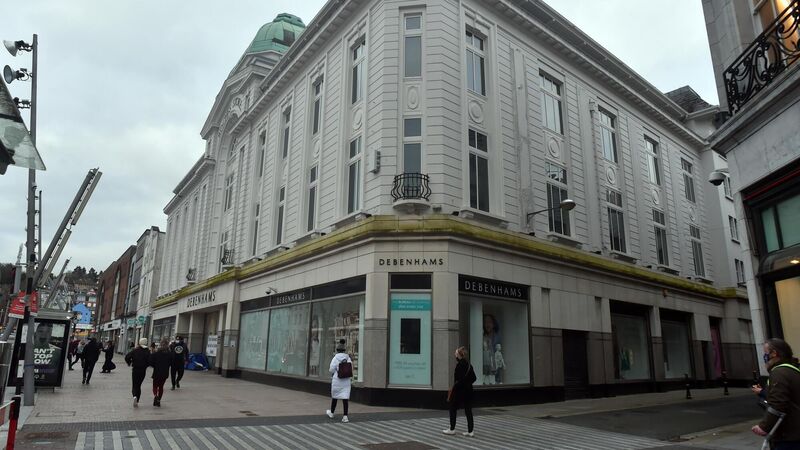Michael Moynihan: Can the city be made safer for women in the shorter term?

Patrick Street, Cork. A male may see a city’s streets as having character and intrigue. A woman can see a series of threatening alleyways and potential hiding places for assailants.
The murder of Sarah Everard last week in London has led, unsurprisingly, to outrage and protests in that city. It’s equally unsurprising that those protests have been dealt with in a heavy-handed and disproportionate fashion, but that’s not what I want to dwell on here.
The reasons a city is unsafe for women have everything to do with the men who make it unsafe. That’s not at issue.
Neither is the need for men to be better, to put this idea at its absolute blandest and broadest, in their interactions with women everywhere, not just on the streets of the city.
Calls for men to improve, or to raise sons with a better understanding of these issues, are fine, but is there more that can be done? Can the city be made safer for women in the shorter term?
It would help to look at the city in a different way if you’re a man, of course. A cursory glance at social media will unearth dozens of male confessions of complacency about being free to run or jog anywhere in the city without fear or concern, but the disparity between male and female perception of the urban setting goes far deeper than that.
A male visitor — or resident — may see a city’s older quarters as full of atmospheric, narrow streets, hinting at character and intrigue, true to a medieval heritage and suggesting a vibrant urban space.
A woman can see a series of threatening alleyways and potential hiding places for assailants: deserted lanes and dark spaces suggest a mugger’s playground rather than an olde-worlde theme park.
A comparison? Take the broad footpaths and well-lit streetscapes of the South Mall and Patrick Street in Cork, and compare the winding laneways on both sides of the city, the narrow streets to be found hard by the North and South Channels.
Without casting aspersions on anyone living in, working in or travelling through those latter areas, the former spaces fulfil many of the criteria identified as desirable in a study which examined attitudes among London residents about safety in urban areas.
A ‘Making Places Safer' study canvassed opinions in three different parts of that city and identified key elements in creating a safe environment.
These included good lighting; maintaining clear sightlines in public areas, created by cutting back shrubbery; giving pedestrians priority; clear signage; public places that are occupied by a wide range of people; and general maintenance.
All of these make sense. Having public places which are well-lit, well maintained, clearly signposted, occupied by a diverse group of people and which don’t have shady corners is obviously a more enticing proposition than the opposite — for everyone.
If that checklist strikes you as obvious, good on you. For the rest of us, though, consultation is necessary, because the evidence suggests that consultation pays off.
Almost thirty years ago in Vienna, for instance, a collection of city planners put together a photography exhibition entitled “Who Owns Public Space — Women’s Everyday Life in the City.”
The photographs showed the daily routines of a diverse group of women as they went about their lives in the Austrian capital: each woman took a different route through the city, and they ended up at a variety of destinations.
All of the photographs, however, made one thing clear. Safety and ease of movement in the city were two of their most important priorities in day-to-day life, and the city of Vienna took that on board.
For instance, one of the pilot projects which was built as a result was an apartment complex designed for and by women in the city’s 21st district.
In 1993, the city held a design competition for the project, which was to be known as Frauen-Werk-Stadt (Women-Work-City).
The project resulted in a complex made up of a series of apartment buildings surrounded by courtyards, and circular grassy areas in the courtyards to allow parents and children to spend time in the open air without having to go far from home.
The complex has a kindergarten, pharmacy and doctor’s office on site, and it’s also close to public transit: this makes running errands and getting to school and work easier.
This accessibility to public transport is an important part of making the city safer for women, because data collected all over the world suggests that women are more likely to use public transit than men; therefore it makes sense to make those transit systems easier to access, and safer for those people who use them.
This was articulated nicely by Daniel Helldén, vice mayor of Stockholm, in an interview about the city’s snow-clearing policy.
(Interesting aside on this: after heavy snow Stockholm clears footpaths first, to encourage people to walk; cycleways second, to encourage people to cycle; and roadways last, for drivers.)
“We want to have a gender equal city,” Helldén said by way of context.
“And we know that women are more seldom driving cars than men.
“Men are sitting in the cars and the women walk, cycle and go by public transportation in much higher amounts. So we're trying to change it so women get more of the public spending.
“We know with numbers that there are more men sitting in cars here, at least in Stockholm, than out walking and taking public transportation.
“We are trying to change the traffic system in Stockholm in a way that (gets) more people to walk, cycle and go by public transportation because we want a nicer city, a cleaner city and we want to reach our climate goals.”
And here, of course, everything intersects.
A city that is cleaner and greener is also a city that has a better public transportation system, one which is more widely used, as well as widespread cycle lanes and walking routes.
And because those elements of the urban experience are more female-friendly, committing to those elements of city improvement make the environment safer for women as a consequence.
In the Cork context, this has all sorts of local applications as well. Consider the derelict buildings dotted all over the city, as chronicled for the last twelve months by Frank O’Connor and Jude Sherry.
If these alone were addressed it would make the city feel far safer for all its inhabitants. There wouldn’t be as many vacant spaces available for anti-social behaviour, let alone the sheer danger factor from buildings at risk of collapse.
Action here would also provide more spaces for people to live and work in. It would improve the appearance of many streets and create a better atmosphere within the city, not to mention the double-whammy of generating revenue within and for the city.
It would also echo what the vice-mayor of Stockholm said about creating “a nicer city, a cleaner city and we want to reach our climate goals”.
Finally, in doing all of the above Cork would be a far better space for women as well. What are we waiting for?










